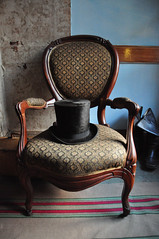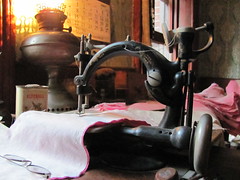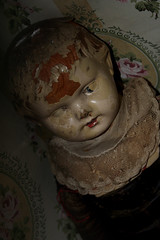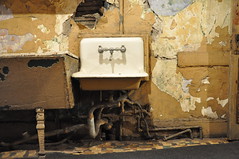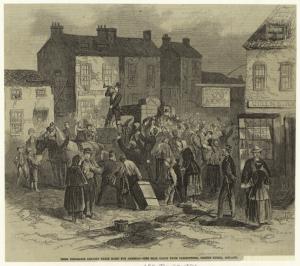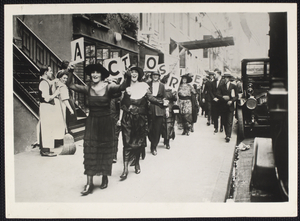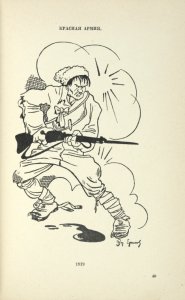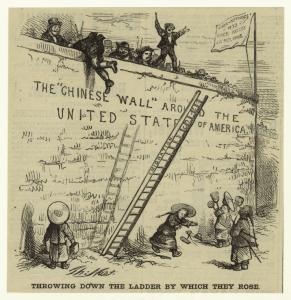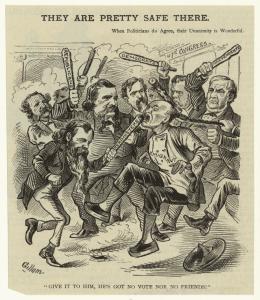Katie Barnard is a costumed interpreter in the
Live! At the Tenement program, portraying Bridget Moore. I recently spoke with her both in and out of character.
Can you tell me a little bit about who you’re portraying in this program?
I’m portraying Bridget Moore, an Irish immigrant who lived in the building in 1869 with her family.
What responsibilities do you have to keep your character accurate?
Mostly things about correctly portraying what’s good about living here for her but also the truth of her story, which I think is a tumultuous one. The trip across the ocean, leaving the homeland and the famine. What does that turn a person into, if they’ve survived but watched people die because of nothing they can control?
And you want her to seem grateful at the same time.
Exactly. It’s a careful balance. It’s interesting because Bridget is different than a lot of the other characters; this house for her is probably the nicest house she’s ever lived in, aside from when she was a maid.
How do you maintain the interest of your audience?
Well, we only have ten minutes so there’s not really a lot of maintenance that has to be done, but usually connection to the space allows visitors to reference things around them, and then stories and anecdotes to back up the how and why of a particular item. It’s hard because you don’t want to be inaccurate historically but at the same time, you should also seem like a human being. And we have the least information about Bridget Moore [out of all the] characters, so it requires a little artistic license.
I think someone in Bridget Moore’s situation would want to entertain, would want to be witty and entertaining with visitors. And I think it’s only in those moments where people ask direct questions about her journey or her homeland that it surprises her a little bit, you know, so that there’s a reaction.
Have you done anything like this costumed interpretation before?
No. I’ve done a lot of acting in general… which is interesting, actually, because in general [when] acting, you’re very specific and accurate. You’re trained to have a lot of research behind you, so costumed interpreting isn’t too far from what you might do if you’re in some sort of play [that’s] set in a different era. I also portray Victoria Confino, [an immigrant who lived in 97 Orchard Street in the 1910s,] in a different program so sometimes my wires get crossed, maintaining the different accents, characters, and time periods. [Laughs.] It gets confusing.
What is the most fun about portraying Bridget Moore?
I think what’s most fun about her are the things that she gets excited about. I imagine from the research that [program coordinator] Sarah Litvin has done, which is brilliant research, we can figure out from the time period what would have been exclusively, like, oh-my-gosh-can-you-believe-I-have-this-thing. So I find the most fun to be figuring out that excitement about something that would seem really trivial to us now. A rug on the floor seems like nothing but to Bridget Moore, that’s a big deal.
Then, program coordinator Sarah Litvin and I met with Bridget Moore…
Could you tell me about yourself, your family, and what you do for a living?
Sure, of course. My name is Bridget Moore. I’ve got a husband Joseph, and I’ve got three wee ones. A girl, Mary Kate. She’s almost four. And a girl, Jane. She’s almost three. And a wee one, Agnes. She was just born, just recently. Joseph works in a saloon, in a pub, you know? Nearby. He does that at night and sometimes during the day. I work here in the house.
How long has your husband been working at the pub?
He’s worked in a pub since I knew him. But he switches from pub to pub depending on the season. Sometimes he works in a hotel, sometimes he works at a pub in the Five Points. It’s depending on whether it’s the busy season or the slow season. He’s got it all figured out.
So he didn’t come to this country with you?
No, no, no. I came here alone when I was wee. I was seventeen or so.
How would you describe your experience since you arrived in the city? How is life in the tenement?
I think it’s pretty nice. The only thing I don’t like so much is slaggin’ all the stairs, you know? You’ve got to climb all the stairs. We don’t have that. When I was in Ireland, it was very different. We were all on the one floor and there was one room and that was it. It’s very complicated with all the stairs and the rooms and all that. And you’ve got to climb the stairs many times in a day because you’ve got to go down there to get water. The well is down out behind the building. But when I first got here, I was a little bit intimidated cause I came from a farm. When you come from a farm, and ya’ arrive in a place like New York, it’s very strange. There’s a lot people from all over. No one in this neighborhood speaks the same language I do, and I had to get really used to that. We’ve only been here a little while in the neighborhood. When you live in the Five Points, it’s a little bit like being in Dublin, I hear. But I don’t know. [Laughs.]
Do you feel you have a strong sense of community here now? Or does it still feel foreign to you?
No, it’s alright. It’s different because my community at home is my family. And here, you learn to make family where you can. I’ve got friends at the church.
So if you could change one thing about the tenement, what would it be? Would it be having to go down all those stairs for water?
It would be the stairs! [Laughs.] But there are other things too, y’know. It’s so dark. I’d like a few more lamps, but right now we don’t have enough money to get them.
SL: Is there anything you do to try to make use of the light you have?
There is. You know, I learned about something. Can I tell you it? When I was uptown, they would say, to make the room make a little bit brighter and larger… they’re always worried uptown about making everything bigger than it is. So they tell you you’ve got to put glass on the wall. Now this is very strange, and Joseph doesn’t like it at all because in Ireland, if you look in the glass, they think you go to the next world. So there’s a lot of worry, but I said, “If you’re in America, you’ve got to put the glass on the wall because here it’s so dark and you’ve got so little space that if you put the glass on the wall like this [points to the mirror hanging on the mantle], it makes it feel bigger and brighter.
What are your hopes for the future in the next couple of years here?
It’s hard to say. This is a pretty nice place so if we could maintain it, that’d be great. If we could get a little more light and stay, that’d be wonderful. [Laughs.] But the only problem is Joseph gets a little restless because there’s no one here from Ireland except one pair upstairs. So he wants to go back to the Five Points, but if I have my way, I don’t think so.
Meet Katie Barnard tomorrow at Live! at the Tenement's evening bash, 6:30 PM at the Museum Shop, 108 Orchard Street.
- Posted by Joe Klarl

